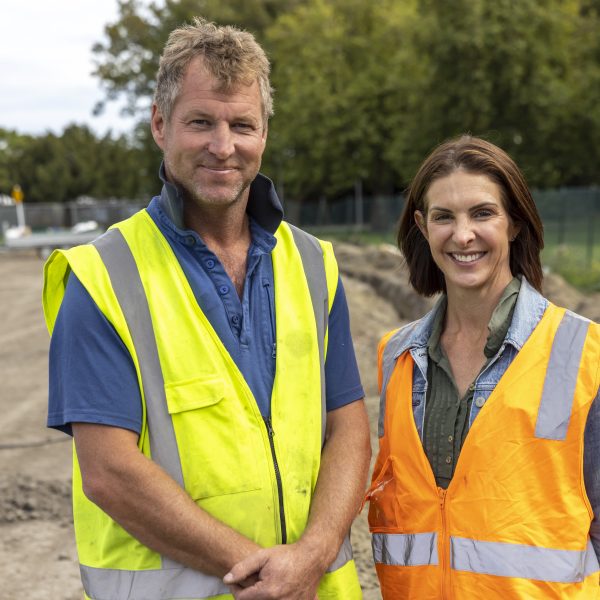
Caption: Gary and Penny Robinson of Robinson Subsurface Drip Irrigation at Linwood Park in Christchurch where their underground irrigation system is being installed.
Cust dairy farmers Gary and Penny Robinson have advanced their Subsurface Drip Irrigation (SDI) trial with positive feedback from farmers following field days at trial blocks in North Canterbury and Central Otago. The system is also being installed at Linwood Park in Christchurch.
Gary and Penny are participating in Next Generation Farming; a project that aims to help farmers meet tough nitrate caps while maintaining their viability. As part of this project, farmers like the Robinsons are using innovation and demonstrating its productivity and environmental benefits to their neighbours in the region and beyond.
Waimakariri Landcare Trust (WLT) and Waimakariri Irrigation Limited (WIL) have partnered with the Ministry for Primary Industries (MPI) for the project, with support from MPI’s Sustainable Food and Fibre Futures fund along with Environment Canterbury, Ballance, and DairyNZ.
SDI’s low-pressure system saves water and power and improves crop yields by eliminating surface water evaporation and reducing the incidence of weeds and disease. Water is applied directly to the root zone of the crop and not to the soil surface.
Gary and Penny recently held two field days at trial blocks in Cust, North Canterbury and in Maniototo, Central Otago which were well received by farmers and industry partners.
Despite heavy rain during the Cust field day, Penny says farmers were keen to learn about subsurface irrigation and seeing the system in the ground and being able to ask practical questions built a stronger understanding of how the system works.
“The weather definitely wasn’t in our favour, but we still had a good turnout, and everyone was very engaged and interested. From the questions asked and discussion we had, SDI does seem to be accepted as a viable solution and option for irrigation in New Zealand.”
Over 50 farmers turned out for the Maniototo field day where the difference between the 18-hectare test block using subsurface irrigation and the adjacent block using traditional irrigation was evident, says Gary.
“It was a stinking hot day, and it was perfect because they have had a hot and dry summer down there so you could really see the difference with lush green grass growing on the block where we have installed the SDI.
“The farmer, Luke Jeffries, is really impressed with the system and after the field day we had quite a few local farmers approach us to learn more.”
Gary and Penny are now focused on gathering data to prove the benefits of the subsurface drip irrigation system and have some interesting projects in the pipeline.
“We’ve had lots of interest from farmers, and we are also in discussions about using the SDI system for wastewater. We feel like we are on a roll now in terms of public awareness of how the system works and the benefits it provides.”
Meanwhile, working on the installation of their first SDI system for a recreational area has been an exciting opportunity for Gary and Penny. Christchurch City Council is remediating Linwood Park following its use as a site for temporary housing after the Canterbury earthquakes. Penny says the environmental and practical benefits make SDI an ideal option for the Council because it saves power and uses less water.
Gary and Penny will now focus on gathering and analysing data from their Maniototo test block, while also exploring opportunities for the SDI system to be used for wastewater, and meeting with farmers to discuss installing the underground irrigation system on their farms.




